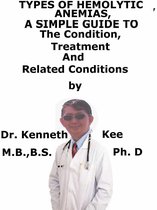Types of Anemia, A Simple Guide To The Condition, Diagnosis, Treatment And Related Conditions Ebook Tooltip Ebooks kunnen worden gelezen op uw computer en op daarvoor geschikte e-readers.
Afbeeldingen
Sla de afbeeldingen overArtikel vergelijken
- Engels
- E-book
- 9780463951712
- 21 december 2018
- Epub zonder kopieerbeveiliging (DRM)
Samenvatting
This book describes Types of Anemia, Diagnosis and Treatment and Related Diseases
Anemia is a disorder that develops when the blood does not have enough healthy red blood cells or hemoglobin.
Hemoglobin is an essential part of red blood cells and binds oxygen.
If the patient has too few or abnormal red blood cells, or the hemoglobin is abnormal or low, the cells in the body will not get enough oxygen.
Symptoms of anemia like fatigue happen because organs are not getting what they need to function properly.
Some types of anemia are hereditary and infants may be involved from the time of birth.
Women in the childbearing years are mostly vulnerable to iron-deficiency anemia because of the blood loss from menstruation and the higher blood supply demands during pregnancy.
Older adults also may have a greater danger of developing anemia because of poor diet.
Iron-deficiency anemia, the most frequent type, is very treatable with diet changes and iron supplements.
There are more than 400 forms of anemia, which are classified into 3 groups:
1.Anemia produced by blood loss
Red blood cells can be lost through bleeding, which often can occur slowly over a long period undetected.
a.Gastrointestinal disorders such as ulcers, hemorrhoids, gastritis and cancer
b.Use of non-steroidal anti-inflammatory drugs such as aspirin, which can produce ulcers and gastritis
c.Menstruation, if menstrual bleeding is excessive
2.Anemia produced by decreased or abnormal red blood cell production
With this form of anemia, the body may form too few blood cells or the blood cells may not function correctly
Red blood cells may be faulty or reduced due to abnormal red blood cells or a lack of minerals and vitamins needed for red blood cells to work properly:
a.Sickle cell anemia
b.Iron-deficiency anemia
c.Vitamin B12 deficiency
d.Bone marrow and stem cell problems
Aplastic anemia occurs when there is a marked reduction in the number of stem cells or absence of these cells.
Aplastic anemia can be inherited, can occur without apparent cause, or can happen when the bone marrow is injured by medicines, radiation, chemotherapy, or infection
Thalassemia is an inherited disorder that occur when the red cells cannot mature and grow properly
This disorder can vary in severity from mild to life threatening; the most severe form is called Cooley's anemia.
Lead exposure is toxic to the bone marrow, producing fewer red blood cells.
Lead poisoning happens in adults from work-related exposure and in children who eat paint chips.
Anemia linked with other disorders normally happens when there are too few hormones for red blood cell production:
a.Advanced kidney disease
b.Hypothyroidism
c.Other chronic diseases, such as cancer, infection, lupus, diabetes, and rheumatoid arthritis
d.Old age
3.Anemia produced by destruction of red blood cells
When red blood cells are fragile and cannot resist the routine stress, they may burst prematurely, causing hemolytic anemia:
a.Inherited conditions, such as sickle cell anemia and thalassemia
b.Stressors such as infections, drugs, snake or spider venom, or certain foods
c.Toxins from advanced liver or kidney disease
d.Improper attack by the immune system
e.Vascular grafts, prosthetic heart valves, tumors, severe burns, exposure to certain chemicals, severe hypertension, and clotting disorders
Symptoms of anemia can be anything from shortness of breath and dizziness to headaches, pale skin, chest pain, fast heart rate, and cold hands and feet.
Treatments depend on the cause of anemia with supplement of Vitamin B12, folate and minerals.
A way to treat anemia is with a blood transfusion
A stem cell transplant also treats most anemia
TABLE OF CONTENT
Introduction
Chapter 1 Types of Anemia
Chapter 2 Treatment
Chapter 3 Iron Deficiency Anemia
Chapter 4 Hemolytic Anemia
Chapter 5 Pernicious Anemia
Chapter 6 Megaloblastic Anemia
Chapter 7 Aplastic Anemia
Chapter 8 Rare Anemias
Epilogue
Productspecificaties
Inhoud
- Taal
- en
- Bindwijze
- E-book
- Oorspronkelijke releasedatum
- 21 december 2018
- Ebook Formaat
- Epub zonder kopieerbeveiliging (DRM)
Betrokkenen
- Hoofdauteur
- Kenneth Kee
- Hoofduitgeverij
- Smashwords Edition
Lees mogelijkheden
- Lees dit ebook op
- Android (smartphone en tablet) | Kobo e-reader | Desktop (Mac en Windows) | iOS (smartphone en tablet) | Windows (smartphone en tablet)
Overige kenmerken
- Studieboek
- Nee
EAN
- EAN
- 9780463951712
Je vindt dit artikel in
- Boek, ebook of luisterboek?
- Ebook
- Taal
- Engels
- Beschikbaarheid
- Leverbaar
- Beschikbaar in Kobo Plus
- Beschikbaar in Kobo Plus
Kies gewenste uitvoering
Prijsinformatie en bestellen
De prijs van dit product is 2 euro en 61 cent.- E-book is direct beschikbaar na aankoop
- E-books lezen is voordelig
- Dag en nacht klantenservice
- Veilig betalen
Rapporteer dit artikel
Je wilt melding doen van illegale inhoud over dit artikel:
- Ik wil melding doen als klant
- Ik wil melding doen als autoriteit of trusted flagger
- Ik wil melding doen als partner
- Ik wil melding doen als merkhouder
Geen klant, autoriteit, trusted flagger, merkhouder of partner? Gebruik dan onderstaande link om melding te doen.








